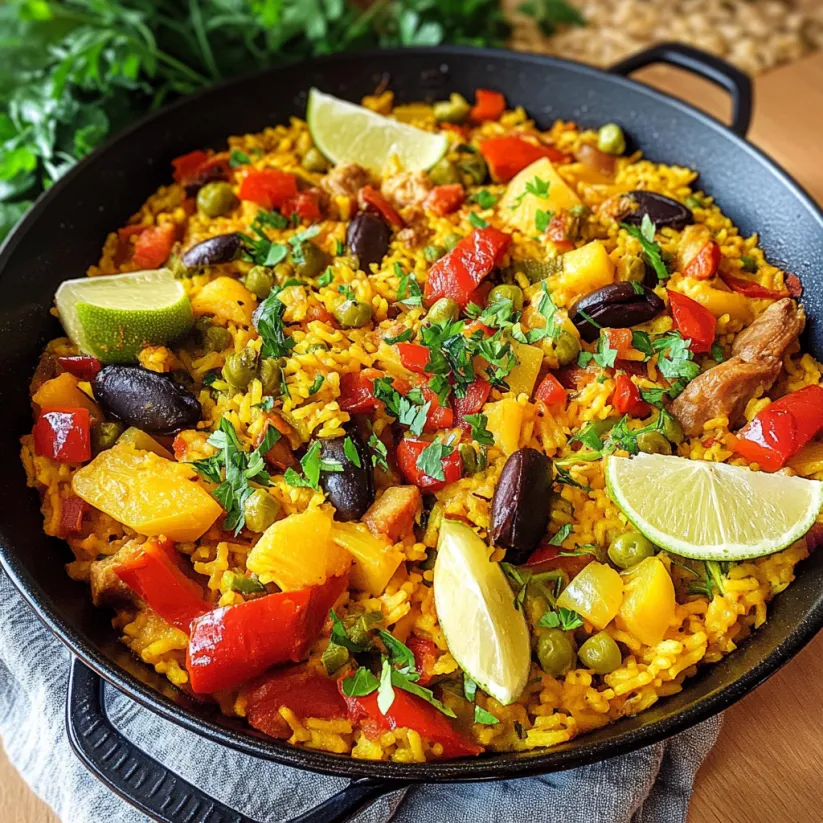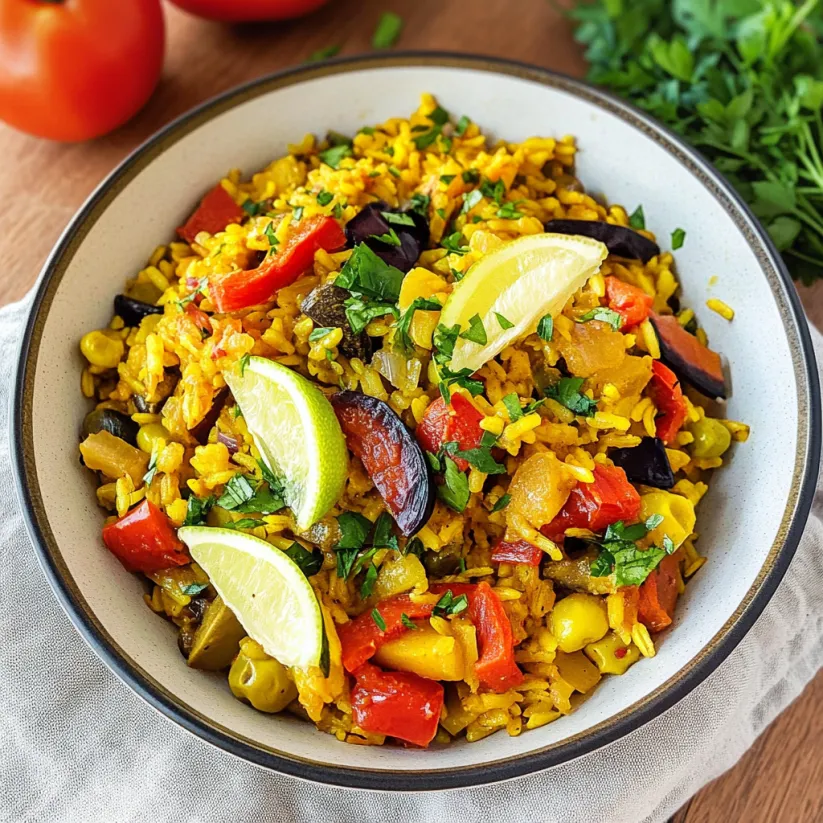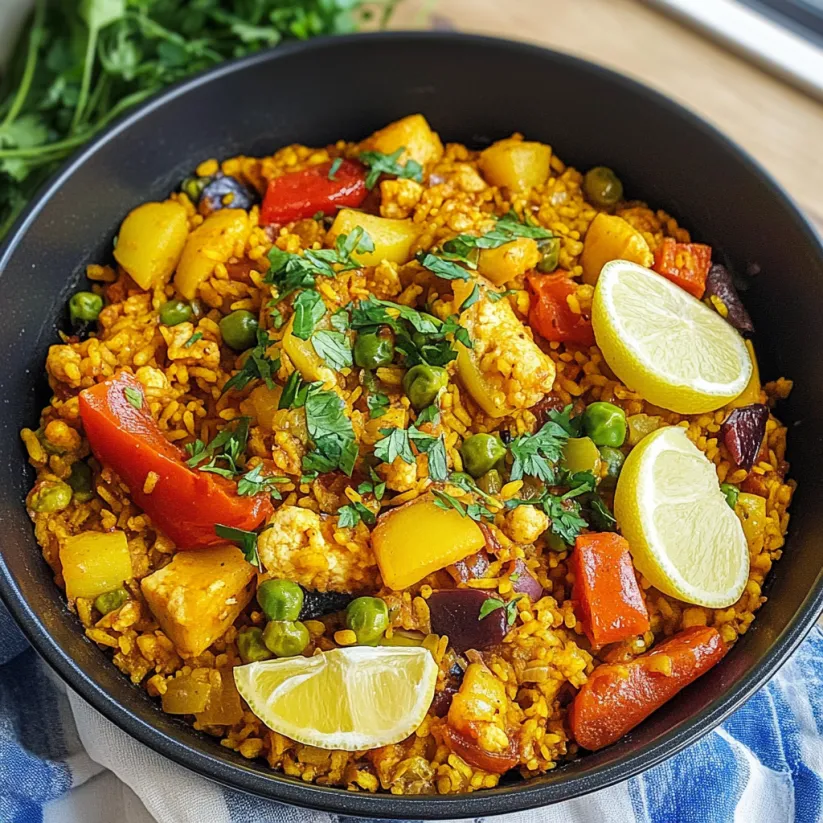 Save Pin
Save Pin
This vibrant vegetarian paella transforms a traditional Spanish dish into a colorful 30-minute meal perfect for busy weeknights. The saffron-infused rice creates the authentic golden hue while seasonal vegetables add nutrition and visual appeal. Best of all, you can make it in any large skillet without needing special equipment.
I discovered this recipe while trying to recreate a memorable paella I enjoyed in Barcelona. After several attempts, this version has become my family's favorite meatless Monday meal, with everyone fighting over the crispy bottom layer.
Ingredients
- Extra virgin olive oil provides the authentic Mediterranean base flavor and helps sauté vegetables properly
- Onion and garlic form the aromatic foundation that builds depth into the dish
- Red bell pepper adds sweetness and traditional Spanish character
- Carrots bring natural sweetness and bright color contrast
- Cherry tomatoes provide bursts of acidity to balance the rich rice
- Spinach offers nutrition and beautiful green color throughout the dish
- Green peas add sweetness and protein to make this a complete meal
- Artichoke hearts deliver meaty texture and subtle earthy flavor
- Black olives contribute brininess and umami that replaces traditional seafood notes
- Smoked paprika adds authentic Spanish smoky depth if you choose to include it
- Saffron threads are essential for authentic color and distinctive floral flavor
- Spanish rice is crucial for the correct texture use only short grain varieties
- Vegetable broth infuses flavor throughout the rice as it cooks
- Fresh parsley brightens the finished dish with color and herbaceous notes
- Lemon wedges provide essential acidity when served
Step-by-Step Instructions
- Heat the Vegetable Broth
- Begin by warming your broth in a small pot. Having hot liquid ready prevents temperature drops when adding to the rice which would lengthen cooking time and affect texture. Keep it simmering gently on a back burner throughout preparation.
- Prepare the Saffron
- Place your precious saffron threads in a small bowl with 4 tablespoons of the hot broth. Allow them to steep for a full 10 minutes. This blooming process releases maximum color and flavor from the threads that would otherwise remain locked inside.
- Sauté the Aromatics
- Add olive oil to your largest skillet over medium heat until it shimmers. Add chopped onion and garlic, cooking gently for about 3 minutes until the onion becomes translucent but not browned. This creates the flavor foundation for the entire dish.
- Build the Vegetable Base
- Add bell peppers and carrots to the softened aromatics. Sauté for 3 to 5 minutes until they begin to soften slightly. Season with a small pinch of salt to draw out moisture and flavor. Add smoked paprika if using, allowing it to toast briefly to release its aromatic oils.
- Incorporate Rice and Remaining Vegetables
- Add frozen peas, olives, and chopped spinach to the pan, then sprinkle in the unrinsed rice. Stir everything together and allow the rice to toast for about 2 minutes which develops nutty flavors. Pour in your saffron with its soaking liquid, stirring to distribute the golden color.
- Add Broth and Begin Cooking
- Pour 3 1/2 cups of hot broth slowly and evenly across the entire pan. Bring everything to a gentle boil, then reduce heat to medium. Arrange artichoke hearts decoratively on top. From this point forward, never stir the rice to allow the traditional bottom crust to form.
- Monitor Cooking Process
- Let the paella cook undisturbed for 15 to 18 minutes. At the 10 minute mark, check if the rice is absorbing liquid properly. If needed, add more broth in small increments of 1/3 cup. For the last 2 minutes, increase heat slightly to develop the coveted crispy bottom layer called socarrat.
- Rest and Finish
- Remove the paella from heat and arrange fresh cherry tomato halves on top. Cover with a lid or foil and allow it to rest for 5 to 10 minutes. This resting period completes the cooking process and helps flavors meld together. Garnish with fresh parsley and serve with lemon wedges.
 Save Pin
Save Pin
Saffron is what makes this dish truly special for me. I remember the first time I splurged on real Spanish saffron at a specialty market rather than using substitutes. The distinctive honeyed floral aroma transformed my cooking instantly, and now I always keep a small supply in my pantry just for special dishes like this.
Perfect Rice Selection
Spanish rice varieties like Bomba or Calasparra are specifically designed for paella with their unique ability to absorb flavors while maintaining distinct grains. These short grain varieties expand mostly in width rather than length, absorbing up to three times their volume in liquid without becoming mushy. If you cannot find true Spanish rice, Arborio rice makes a reasonable substitute as it has similar absorbency properties, though the texture will be slightly different. Never use long grain varieties like basmati or jasmine as they lack the necessary starch content and will result in a disappointing texture.
Creating Authentic Socarrat
The crispy bottom layer of paella, known as socarrat, is considered the crown jewel of this dish. To achieve it successfully, resist the urge to stir once you have added the broth. In the final few minutes of cooking, increase the heat slightly and listen for a gentle crackling sound from the bottom of the pan. This indicates the formation of the caramelized layer. Be careful not to burn it by staying nearby during this process. If you smell anything charring rather than caramelizing, immediately remove from heat. The perfect socarrat should be a thin, golden brown layer that adds textural contrast and concentrated flavor.
Seasonal Adaptations
This paella welcomes adaptation based on what vegetables are in season. In summer, replace carrots with diced zucchini or yellow squash and add fresh corn kernels. During fall, include diced butternut squash and mushrooms for earthier flavors. Winter variations benefit from hearty additions like brussels sprouts or cauliflower florets. Spring paella shines with asparagus tips, fresh peas instead of frozen, and tender fava beans. The key to successful substitutions is maintaining a similar volume of vegetables and ensuring they require roughly the same cooking time, adding quicker cooking items later in the process.
Serving Suggestions
Present your finished paella in its cooking vessel for dramatic effect, bringing it directly to the table for serving. Traditional Spanish accompaniments include a simple green salad dressed with olive oil and sherry vinegar to provide fresh contrast. A crusty bread like pa amb tomàquet tomato bread from Catalonia makes the perfect vehicle for capturing any remaining juices. Enhance the experience with Spanish wine pairings either a crisp Albariño white wine or a fruit forward Tempranillo red depending on your preference. For alcohol free options, a pitcher of citrus infused water complements the meal beautifully.
 Save Pin
Save Pin
Commonly Asked Questions
- → What type of rice should I use for vegetarian paella?
Use Spanish rice (also known as Bomba, Valencia, or Calasparra rice) for authentic results. Arborio or medium-grain rice make good alternatives. Avoid brown rice, long-grain rice, or basmati rice as they won't provide the correct texture. Importantly, don't wash the rice before cooking - the starch is essential for proper paella consistency.
- → Can I make paella without saffron?
While saffron gives traditional paella its distinctive flavor and color, you can substitute saffron powder if authentic threads are too expensive. As a budget alternative, use one tablespoon of tomato paste. Avoid turmeric as a substitute, as it creates a less authentic flavor profile.
- → Why shouldn't I stir paella while cooking?
Never stir paella after adding the broth. This allows the bottom layer of rice to caramelize and form socarat - the prized crispy layer that gives authentic paella its distinctive texture and flavor. Stirring would prevent this from developing and create a more risotto-like consistency instead.
- → Do I need a special paella pan?
No special paella pan is required. Any large skillet (12-inch or larger) works perfectly. The important factor is choosing a pan wide enough to spread the rice thinly, ensuring even cooking without stirring. The wider the pan, the more surface area for the crispy bottom to develop.
- → Why is resting time important for paella?
Don't skip the 5-10 minute resting time with the pan covered. This allows the paella to finish cooking, absorb any remaining moisture, and develop its full flavor profile. Even if you're in a hurry, a minimum 5-minute rest will significantly improve the final texture and taste of your dish.
- → What creates the crispy bottom layer in paella?
The socarat (crispy bottom layer) forms naturally during the final minutes of cooking when you slightly increase the heat. This caramelization of the rice creates a thin toasted layer that adds incredible flavor and texture. Check for a subtle toasty aroma and listen for a slight crackling sound to know it's developing properly.
